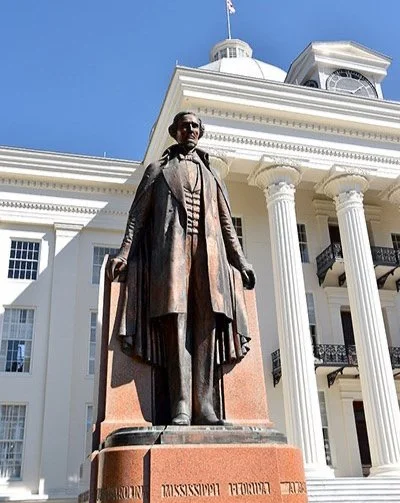The Public Square
Photo of Jefferson Davis, President of the seceded south during the American Civil War, Photo by Ron Cogswell. From Arlington, Virginia, USA. Creative Commons 2.0.
All over the country, statues and memorials to our past and the people who made it are being torn down and removed from the public space—all so that no one in our hyper-sensitive present might risk offense. The public square used to have a special purpose. It’s always been a place to buy and sell, but behind all of that (and sometimes in front) it was a reflection of ourselves—truthful, false or idealized. The buildings housed not just commerce but also culture and meaning. It was the place where any and all could gather and participate in community life, celebrate a shared belief or conversely protest and define an alternative. It was a place for the common man to play his vital role in shaping a culture—just as the university, the church and the palace gave expression to the other sources of the western tradition.
The public space was where we used to commemorate our heroes with the reasonable understanding that knowing our past was key to forging a future. It never meant that our values and who we celebrate must stay constant. We can change our mind about a hero from the past and now say that he was a slave holder, or a greedy industrialist, or whatever the current target of disdain. But we shouldn’t eradicate the record, the history. The value of public monuments comes from the fact that they are an expression of people at a particular time and in a particular place. Keeping the collective history, keeps the culture as it changes and evolves.
Just look how our culture becomes ever more debased as the public square loses its purpose and function. Instead of our history and our heroes—good, bad, and forgotten— we have the culturally devoid space of commerce—two-way traffic, shops, parking lots and strip malls. There’s nothing left to venerate and inspire only things to buy and sell. The marketplace has always been important don’t misunderstand me! And the further back in time you go, it was the absolute heartbeat of a culture where people from all walks of life could gather, talk exchange ideas, goods and money and stay in touch with the world in general. With trade in goods and services having basically taken over the world as it has, the exchange of ideas has retreated inside and become more isolated and therefore more balkanized. We all have our preferred outlets for news and culture, but the digital world has made connection seemingly ubiquitous yet false. And as we’re all tired of recognizing, this leads to misunderstanding and disconnection. So we find ourselves increasingly alone ordering our food and stuff through the Internet along with our news with no need to learn how to get along with other people who hold different values and beliefs. Of course, the public space was more important when populations were more unequal. Since the world has created so much more wealth and there are people who call themselves middle class and citizens (oh my heavens), there’s less need for a cathedral say where though staffed by the educated class, one need only be a human and hopefully a Christian to enter. The cathedral was civic life at its most perfect, I believe, with its architecture demanding that we look up and think about something other than our feet on the ground and what we’re going to do that day. And to be honest, belief in the Holy Trinity has always gone through its trials.
I’m a hopeless medievalist, but we needn’t go back that far in time to find a more nourishing civic space. The great cities of Europe and here too in the new world used to have beautiful public buildings, where people could meet each other or have the perhaps less salutary confrontation with the authorities ( you can’t beat city hall, but you can admire the building). Europe still does because the restless urge to tear down the past to erect the future that has always been a part of the American DNA, thankfully never took hold over there.
Alas, here in the U.S. we’ve almost entirely destroyed some of the great public buildings and spaces or in some cases removed features that offend people today though provided history, personality and context. Think of the original Penn Station in New York and compare it to the rat hole that took its place. Public buildings share the same fate as public monuments. Public buildings must be able to survive a modern economy and part of doing that means it has to be self-supporting and sustainable. Public monuments need to be inoffensive to the people at large and if not those who maintain it might be unable to do their business. Even if their business is representative government, the result is the same—the destruction of our shared history, culture and the public expression of it. It makes one yearn for a statue of a slaveholder or greedy industrialist.

